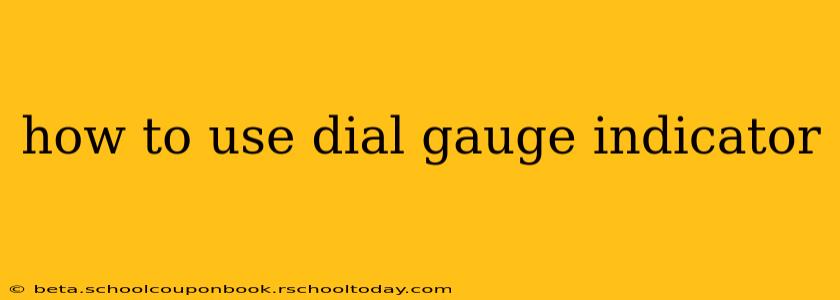Dial gauge indicators, also known as dial indicators or test indicators, are precision instruments used to measure small displacements or variations in surface height. They're essential tools in various fields, from machining and automotive repair to quality control and engineering. Understanding how to use a dial gauge indicator correctly is crucial for accurate measurements and avoiding damage to the instrument. This guide will walk you through the process, covering everything from setup to reading the dial.
Understanding Dial Gauge Indicator Components
Before diving into usage, let's familiarize ourselves with the key components:
- Dial: The circular face displaying the measurement in increments (typically 0.001 inches or 0.01 mm).
- Pointer: The needle indicating the measured value on the dial.
- Stem: The rod extending from the dial, often with a contact point.
- Bezel: The ring surrounding the dial, sometimes used for adjusting the zero point.
- Base (or Shank): The part that provides support and mounting options. This can vary depending on the type of dial gauge. Some have magnetic bases, while others have clamp mounts or threaded shanks.
- Contact Point (or Plunger): The part that makes contact with the surface being measured. This is often replaceable and can be chosen based on the surface being measured.
Setting Up Your Dial Gauge Indicator
Proper setup is paramount for accurate readings. Here's a step-by-step guide:
- Choose the Right Gauge: Select a dial gauge with an appropriate range and measurement increment for your application. A gauge with too small a range won't work for larger measurements, and one with too large a range won't provide sufficient precision for fine measurements.
- Zeroing the Gauge: With the contact point lightly resting on a flat, stable surface, adjust the bezel to align the pointer with zero. Ensure the gauge is firmly mounted and not wobbling.
- Mounting the Gauge: Securely mount the gauge to your work surface using the appropriate method for its base type. A firm and stable mount is essential for precise measurements. Consider using a magnetic base on ferrous materials or a vice for secure clamping.
- Contact Point Selection: Ensure the contact point is suitable for the surface being measured. A blunt or damaged contact point can lead to inaccurate readings.
Taking Measurements with a Dial Gauge Indicator
Now, let's explore how to effectively use the gauge for various measurements:
Measuring Surface Variations
- Gentle Contact: Gently bring the contact point into contact with the surface to be measured. Avoid applying excessive force, as this can damage the gauge or lead to inaccurate readings.
- Observe the Pointer: Observe the pointer's movement on the dial as the surface varies.
- Read the Measurement: Record the measurement indicated by the pointer. Remember to note the units (inches or millimeters).
Measuring Runout (Circular Variations)
- Secure Mounting: Firmly mount the gauge to a stable base.
- Rotate the Object: Rotate the object you're measuring, ensuring the contact point maintains consistent pressure.
- Monitor Pointer Fluctuation: Observe the pointer's maximum and minimum deviations to determine the runout.
Measuring Depth or Height
- Reference Point: Establish a clear reference point.
- Contact Point Adjustment: Adjust the contact point to the reference point and zero the gauge.
- Measure the Depth: Measure the depth or height from the reference point.
Maintaining Your Dial Gauge Indicator
Proper care extends the lifespan and accuracy of your dial gauge:
- Cleaning: Regularly clean the gauge with a soft cloth.
- Storage: Store the gauge in its case to protect it from damage and dust.
- Calibration: Periodically calibrate your gauge to ensure accurate measurements. Calibration should be performed by a qualified technician.
Troubleshooting Common Issues
- Inconsistent Readings: Check for loose mounting, damaged contact points, or surface irregularities.
- Pointer Sticking: Clean and lubricate the gauge as needed.
- Zeroing Difficulties: Ensure the gauge is properly mounted and that the zeroing mechanism is functioning correctly.
By following these instructions and maintaining your dial gauge indicator properly, you can ensure accurate and reliable measurements for your projects. Remember safety always comes first; always handle this delicate instrument with care.
